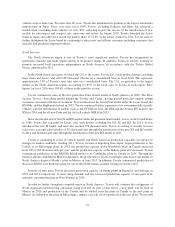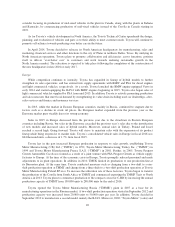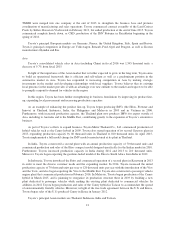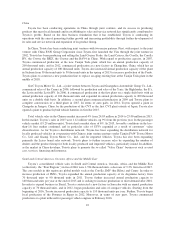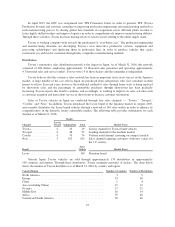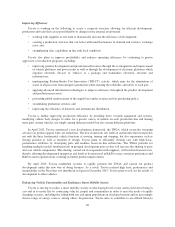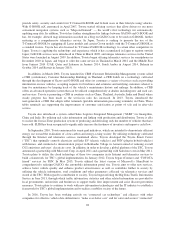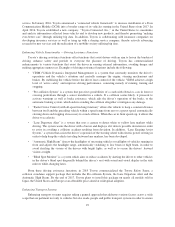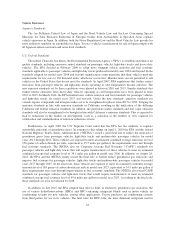Toyota 2015 Annual Report Download - page 33
Download and view the complete annual report
Please find page 33 of the 2015 Toyota annual report below. You can navigate through the pages in the report by either clicking on the pages listed below, or by using the keyword search tool below to find specific information within the annual report.provide safety, security and comfort for T-Connect/G-BOOK and G-Link users in their lifestyle using vehicles.
With G-BOOK mX announced in April 2007, Toyota started offering services that allow drivers to use more
convenient navigation systems such as “Map-on-Demand” — the world’s first technology for automatically
updating map data. In addition, Toyota has further strengthened its linkage between GAZOO and G-BOOK and
has, for example, allowed map information searched on a blog on GAZOO.com to be used on G-BOOK, further
maturing as a comprehensive telematics service. In Japan, Toyota is seeking to promote the use of the
T-Connect/G-BOOK by equipping all Lexus models and certain Crown models with the T-Connect/G-BOOK as
a standard feature. Toyota has also licensed its T-Connect/G-BOOK technology to certain other competitors in
Japan. Toyota is applying the technology and experience which it has accumulated in Japan to regions outside
Japan; G-BOOK services were introduced in China in March 2009, and unique telematics services in the United
States were launched in August 2009. In addition, Toyota began offering telematics services for smartphones in
December 2010 in Japan, and began to offer the same service in Thailand in March 2012 and the Middle East
from January 2014 (UAE, Qatar and Lebanon in January 2014, Saudi Arabia in August 2014, Bahrain in
October 2014 and Kuwait in January 2015).
In addition, in March 2004, Toyota launched its CRM (Customer Relationship Management) system called
e-CRB (evolutionary Customer Relationship Building) in Thailand. e-CRB builds on a technology cultivated
through the development of Gazoo and G-BOOK and offers its customers a variety of services such as providing
information on new vehicles, accepting requests for brochures and estimates and notifying customers when it is
time for maintenance by keeping track of the vehicle’s maintenance history and mileage. In addition, e-CRB
offers an advanced operation system that can be utilized comprehensively at dealers including new and used cars
and services. Toyota is promoting e-CRB in countries such as China, Thailand, Australia, India and Brazil where
steady progress has been made as the service-in ratio has increased. In 2013, Toyota introduced the
next-generation e-CRB that adopts tablet terminals (portable information processing terminals) in China. These
tablet terminals are supporting the improvement of customer satisfaction at points of sale and in after-sale
service.
Toyota also introduced a system called Sales Logistics Integrated Management (“SLIM”) in Guangzhou,
China and India. By utilizing real sales information and linking with production and distribution, Toyota is able
to realize the Just-in-Time production system of producing and delivering only the number of vehicles that have
been sold. SLIM has been recognized to significantly increase the freshness of inventory and improve cash flow.
In September 2010, Toyota announced its smart-grid initiatives, which are intended to demonstrate efficient
energy use toward the realization of a low-carbon and energy-saving society. By utilizing technology cultivated
through the Internet and telematics services mentioned above, Toyota developed the Toyota Smart Center
(“TSC”) that optimally controls electricity and links EV (electric vehicles) and PHV (plug-in hybrid vehicles)
with homes, and conducted a demonstration project in Rokkasho Village in Aomori aimed at reducing overall
CO2 emissions and users’ electricity costs. In addition, in order to develop a global platform of the TSC, Toyota
announced a partnership with Microsoft Corp. in April 2011 and a partnership with Salesforce.com in May 2011.
Toyota plans to utilize the cloud technology of these two companies in its Internet and telematics services to
build a framework for TSC’s global implementation. In January 2012, Toyota began eConnect and “TOYOTA
friend” services for PHV. In May 2013, Toyota utilized the latest version of Microsoft’s SharePoint to
comprehensively redesign GAZOO, the automobile information portal site. Toyota aims to offer new services,
achieve better vehicle quality and enhance product attractiveness as well as contribute further to society by
utilizing the vehicle information, road conditions and other parameters collected via telematics services and
stored at the TSC. With regard to contribution to society, Toyota began offering the Big Data Traffic Information
Service in June 2013, through which traffic information, statistics and other related information are provided to
local governments, universities and businesses to support traffic flow improvement and assist disaster prevention
measures. Toyota plans to continue to work with new information technologies and the IT industry to establish a
framework for TSC’s global implementation and to realize a mobility society of the future.
In 2016, Toyota has been working actively on “connected car technology” and alliances with other
companies for effective vehicle data utilization to “make ever-better cars” and for safer and securer “connected”
28



